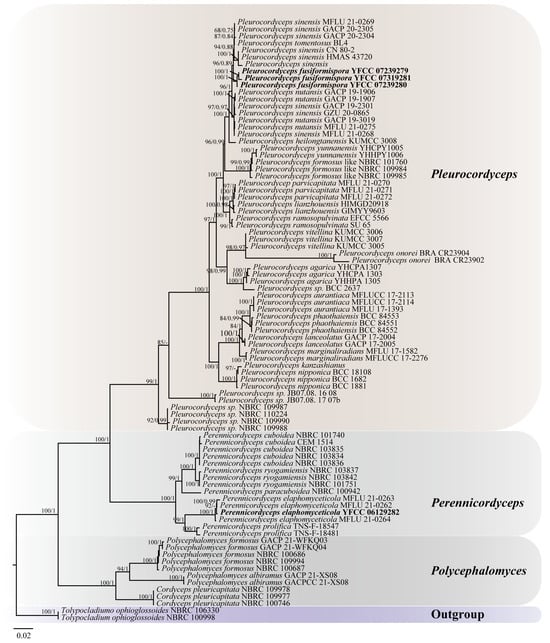Journal Description
Journal of Fungi
Journal of Fungi
is an international, peer-reviewed, open access journal of mycology published monthly online by MDPI. The Medical Mycological Society of the Americas (MMSA) and the Spanish Phytopathological Society (SEF) are affiliated with the Journal of Fungi, and their members receive a discount on the article processing charges.
- Open Access— free for readers, with article processing charges (APC) paid by authors or their institutions.
- High Visibility: indexed within Scopus, SCIE (Web of Science), PubMed, PMC, CAPlus / SciFinder, AGRIS, and other databases.
- Journal Rank: JCR - Q2 (Mycology) / CiteScore - Q1 (Ecology, Evolution, Behavior and Systematics)
- Rapid Publication: manuscripts are peer-reviewed and a first decision is provided to authors approximately 18.4 days after submission; acceptance to publication is undertaken in 2.8 days (median values for papers published in this journal in the second half of 2023).
- Recognition of Reviewers: reviewers who provide timely, thorough peer-review reports receive vouchers entitling them to a discount on the APC of their next publication in any MDPI journal, in appreciation of the work done.
Impact Factor:
4.7 (2022);
5-Year Impact Factor:
5.2 (2022)
Latest Articles
Molecular Phylogenetic and Comparative Genomic Analysis of Pleurocordyceps fusiformispora sp. nov. and Perennicordyceps elaphomyceticola in the Family Polycephalomycetaceae
J. Fungi 2024, 10(4), 297; https://doi.org/10.3390/jof10040297 - 19 Apr 2024
Abstract
►
Show Figures
Several Pleurocordyceps species have been reported as hyperparasitic fungi. A new species, Pleurocordyceps fusiformispora, and a known species, Perennicordyceps elaphomyceticola, are described here based on morphology and phylogenetic evidence from six genes (ITS, SSU, LSU, TET1-α, RPB1, and RPB2
[...] Read more.
Several Pleurocordyceps species have been reported as hyperparasitic fungi. A new species, Pleurocordyceps fusiformispora, and a known species, Perennicordyceps elaphomyceticola, are described here based on morphology and phylogenetic evidence from six genes (ITS, SSU, LSU, TET1-α, RPB1, and RPB2). Pl. fusiformispora differed from the other Pleurocordyceps species by producing flaky colonies, ovoid or elliptic α-conidia, and fusiform or long fusiform β-conidia. Both full genomes of Pe. elaphomyceticola and Pl. fusiformispora were sequenced, annotated, and compared. The antiSMASH and local BLAST analyses revealed significant differences in the number and types of putative secondary metabolite biosynthetic gene clusters, i.e., NPPS, PKS, and hybrid PKS–NRPS domains, between the two species. In addition, the putative BGCs of six compounds, namely ε-poly lysine, 4-epi-15-epi-brefeldin A, Monorden D/monocillin IV/monocillin VII/pochonin M/monocillin V/monocillin II, Tolypyridone, Piperazine, and Triticone DABFC, were excavated in the present study. This study motivates the use of heterologous expression and gene knockout methods to discover novel biologically active SMs from Polycephalomycetaceae.
Full article
Open AccessBrief Report
Determination of Ploidy Levels and Nuclear DNA Content in Cryptococcus neoformans by Flow Cytometry: Drawbacks with Variability
by
Yun C. Chang, Michael J. Davis and Kyung J. Kwon-Chung
J. Fungi 2024, 10(4), 296; https://doi.org/10.3390/jof10040296 - 19 Apr 2024
Abstract
►▼
Show Figures
Flow cytometry is commonly employed for ploidy determination and cell cycle analysis in cryptococci. The cells are subjected to fixation and staining with DNA-binding fluorescent dyes, most commonly with propidium iodide (PI), before undergoing flow cytometric analysis. In ploidy determination, cell populations are
[...] Read more.
Flow cytometry is commonly employed for ploidy determination and cell cycle analysis in cryptococci. The cells are subjected to fixation and staining with DNA-binding fluorescent dyes, most commonly with propidium iodide (PI), before undergoing flow cytometric analysis. In ploidy determination, cell populations are classified according to variations in DNA content, as evidenced by the fluorescence intensity of stained cells. As reported in Saccharomyces cerevisiae, we found drawbacks with PI staining that confounded the accurate analysis of ploidy by flow cytometry when the size of the cryptococci changed significantly. However, the shift in the fluorescence intensity, unrelated to ploidy changes in cells with increased size, could be accurately interpreted by applying the ImageStream system. SYTOX Green or SYBR Green I, reported to enable DNA analysis with a higher accuracy than PI in S. cerevisiae, were nonspecific for nuclear DNA staining in cryptococci. Until dyes or methods capable of reducing the variability inherent in the drastic changes in cell size or shape become available, PI appears to remain the most reliable method for cell cycle or ploidy analysis in Cryptococcus.
Full article

Figure 1
Open AccessReview
Atypical and Unpredictable Superficial Mycosis Presentations: A Narrative Review
by
Zoubir Belmokhtar, Samira Djaroud, Derouicha Matmour and Yassine Merad
J. Fungi 2024, 10(4), 295; https://doi.org/10.3390/jof10040295 - 18 Apr 2024
Abstract
While typically exhibiting characteristic features, fungal infections can sometimes present in an unusual context, having improbable localization (eyelid, face, or joint); mimicking other skin diseases such as eczema, psoriasis, or mycosis fungoides; and appearing with unexpected color, shape, or distribution. The emergence of
[...] Read more.
While typically exhibiting characteristic features, fungal infections can sometimes present in an unusual context, having improbable localization (eyelid, face, or joint); mimicking other skin diseases such as eczema, psoriasis, or mycosis fungoides; and appearing with unexpected color, shape, or distribution. The emergence of such a challenging clinical picture is attributed to the complex interplay of host characteristics (hygiene and aging population), environment (climate change), advances in medical procedures, and agent factors (fungal resistance and species emergence). We aim to provide a better understanding of unusual epidemiological contexts and atypical manifestations of fungal superficial diseases, knowing that there is no pre-established clinical guide for these conditions. Thus, a literature examination was performed to provide a comprehensive analysis on rare and atypical superficial mycosis as well as an update on certain fungal clinical manifestations and their significance. The research and standard data extraction were performed using PubMed, Medline, Scopus, and EMBASE databases, and a total of 222 articles were identified. This review covers published research findings for the past six months.
Full article
(This article belongs to the Special Issue New Perspectives for Superficial Fungal Infections)
►▼
Show Figures
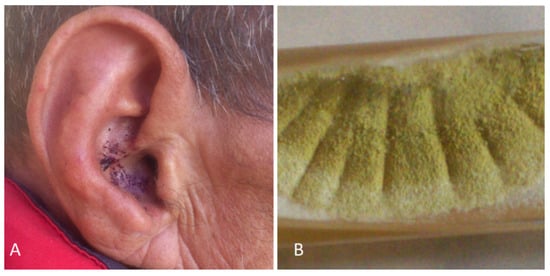
Figure 1
Open AccessReview
Stephanoascus ciferrii Complex: The Current State of Infections and Drug Resistance in Humans
by
Terenzio Cosio, Francesca Pica, Carla Fontana, Enrico Salvatore Pistoia, Marco Favaro, Isabel Valsecchi, Nikkia Zarabian, Elena Campione, Françoise Botterel and Roberta Gaziano
J. Fungi 2024, 10(4), 294; https://doi.org/10.3390/jof10040294 - 18 Apr 2024
Abstract
In recent years, the incidence of fungal infections in humans has increased dramatically, accompanied by an expansion in the number of species implicated as etiological agents, especially environmental fungi never involved before in human infection. Among fungal pathogens, Candida species are the most
[...] Read more.
In recent years, the incidence of fungal infections in humans has increased dramatically, accompanied by an expansion in the number of species implicated as etiological agents, especially environmental fungi never involved before in human infection. Among fungal pathogens, Candida species are the most common opportunistic fungi that can cause local and systemic infections, especially in immunocompromised individuals. Candida albicans (C. albicans) is the most common causative agent of mucosal and healthcare-associated systemic infections. However, during recent decades, there has been a worrying increase in the number of emerging multi-drug-resistant non-albicans Candida (NAC) species, i.e., C. glabrata, C. parapsilosis, C. tropicalis, C. krusei, C. auris, and C. ciferrii. In particular, Candida ciferrii, also known as Stephanoascus ciferrii or Trichomonascus ciferrii, is a heterothallic ascomycete yeast-like fungus that has received attention in recent decades as a cause of local and systemic fungal diseases. Today, the new definition of the S. ciferrii complex, which consists of S. ciferrii, Candida allociferrii, and Candida mucifera, was proposed after sequencing the 18S rRNA gene. Currently, the S. ciferrii complex is mostly associated with non-severe ear and eye infections, although a few cases of severe candidemia have been reported in immunocompromised individuals. Low susceptibility to currently available antifungal drugs is a rising concern, especially in NAC species. In this regard, a high rate of resistance to azoles and more recently also to echinocandins has emerged in the S. ciferrii complex. This review focuses on epidemiological, biological, and clinical aspects of the S. ciferrii complex, including its pathogenicity and drug resistance.
Full article
(This article belongs to the Special Issue Medically Relevant Species of Candida)
►▼
Show Figures
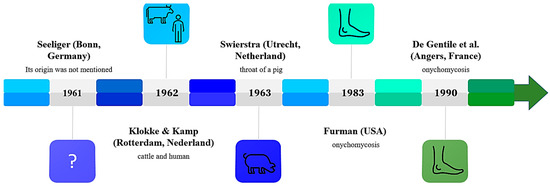
Figure 1
Open AccessArticle
Combination of Systemic and Lock-Therapies with Micafungin Eradicate Catheter-Based Biofilms and Infections Caused by Candida albicans and Candida parapsilosis in Neutropenic Rabbit Models
by
Ruta Petraitiene, Vidmantas Petraitis, Myo H. Zaw, Kaiser Hussain, Rodolfo J. Ricart Arbona, Emanuel Roilides and Thomas J. Walsh
J. Fungi 2024, 10(4), 293; https://doi.org/10.3390/jof10040293 - 17 Apr 2024
Abstract
Vascular catheter-related infections, primarily caused by Candida albicans and Candida parapsilosis, pose significant challenges due to the formation of biofilms on catheters, leading to refractory disease and considerable morbidity. We studied the efficacy of micafungin in systemic and lock therapies to eliminate
[...] Read more.
Vascular catheter-related infections, primarily caused by Candida albicans and Candida parapsilosis, pose significant challenges due to the formation of biofilms on catheters, leading to refractory disease and considerable morbidity. We studied the efficacy of micafungin in systemic and lock therapies to eliminate catheter-based biofilms and deep tissue infections in experimental central venous catheter (CVC)-related candidemia in neutropenic rabbits. Silastic CVCs in rabbits were inoculated with 1 × 103 CFU/mL of C. albicans or C. parapsilosis, establishing catheter-based biofilm, and subjected to various treatments. Neutropenic rabbits treated with a combination of lock therapy and systemic micafungin demonstrated the most significant reduction in fungal burden, from 5.0 × 104 to 1.8 × 102 CFU/mL of C. albicans and from 5.9 × 104 to 2.7 × 102 CFU/mL of C. parapsilosis (p ≤ 0.001), in the CVC after 24 h, with full clearance of blood cultures after 72 h from treatment initiation. The combination of lock and systemic micafungin therapy achieved eradication of C. albicans from all studied tissues (0.0 ± 0.0 log CFU/g) vs. untreated controls (liver 7.5 ± 0.22, spleen 8.3 ± 0.25, kidney 8.6 ± 0.07, cerebrum 6.3 ± 0.31, vena cava 6.6 ± 0.29, and CVC wash 2.3 ± 0.68 log CFU/g) (p ≤ 0.001). Rabbits treated with a combination of lock and systemic micafungin therapy demonstrated a ≥2 log reduction in C. parapsilosis in all treated tissues (p ≤ 0.05) except kidney. Serum (1→3)-β-D-glucan levels demonstrated significant decreases in response to treatment. The study demonstrates that combining systemic and lock therapies with micafungin effectively eradicates catheter-based biofilms and infections caused by C. albicans or C. parapsilosis, particularly in persistently neutropenic conditions, offering promising implications for managing vascular catheter-related candidemia and providing clinical benefits in cases where catheter removal is not feasible.
Full article
(This article belongs to the Special Issue Fifty Years of Fungi: A Special Issue Honoring the Contributions of Dr. June Kwon-Chung to the Field of Medical Mycology)
►▼
Show Figures

Figure 1
Open AccessArticle
The Combination of Enzymes and Conidia of Entomopathogenic Fungi against Aphis gossypii Nymphs and Spodoptera frugiperda Larvae
by
Juliana M. Ferreira, Éverton K. K. Fernandes, Jae Su Kim and Filippe Elias F. Soares
J. Fungi 2024, 10(4), 292; https://doi.org/10.3390/jof10040292 - 17 Apr 2024
Abstract
The slow action of fungi is one of the biggest challenges in using entomopathogenic fungi. A promising alternative to reduce the time of action is to combine conidia with extracellular enzymes. This study aimed to characterize the production of Pr1 subtilisin protease and
[...] Read more.
The slow action of fungi is one of the biggest challenges in using entomopathogenic fungi. A promising alternative to reduce the time of action is to combine conidia with extracellular enzymes. This study aimed to characterize the production of Pr1 subtilisin protease and lipases by Beauveria bassiana and Metarhizium anisopliae in different culture media and to evaluate the efficiency of the enzymatic treatment against Aphis gossypii and Spodoptera frugiperda. The isolates were cultivated in five different liquid cultures, and, after 7 days, the culture was filtered and centrifuged, and the activity of the Pr1 and lipases was measured. The fungi cultured in a Luria–Bertani broth medium had the highest activity of proteases and lipases. The mortality of A. gossypii nymphs treated with conidia 7 days after the treatment was 39% (JEF-410), 76.5% (JEF-492), 74.8% (ERL-836), and 70.9% (JEF-214). The B. bassiana JEF-410 supernatant combined with conidia increased the fungal virulence at day 5 and day 6 after treatment. When S. frugiperda larvae were treated with B. bassiana JEF-492 conidia combined with its supernatant, the time of infection was shorter compared to the larvae treated with conidia only. Once the supernatant was incubated at 37 °C, the relative activity decreased from 100% to 80% after 2 h and to 45% after 24 h. The results suggest that the supernatant of entomopathogenic fungi may be formulated and used as a biopesticide in an efficient strategy for the biological control of pests.
Full article
(This article belongs to the Special Issue Biotechnology of Entomopathogenic Fungi)
►▼
Show Figures
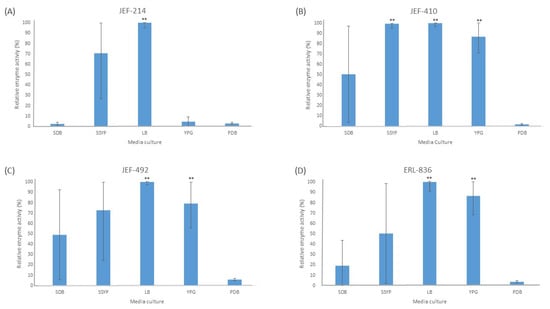
Figure 1
Open AccessArticle
Aspergillus nidulans gfdB, Encoding the Hyperosmotic Stress Protein Glycerol-3-phosphate Dehydrogenase, Disrupts Osmoadaptation in Aspergillus wentii
by
Veronika Bodnár, Károly Antal, Ronald P. de Vries, István Pócsi and Tamás Emri
J. Fungi 2024, 10(4), 291; https://doi.org/10.3390/jof10040291 - 16 Apr 2024
Abstract
The genome of the osmophilic Aspergillus wentii, unlike that of the osmotolerant Aspergillus nidulans, contains only the gfdA, but not the gfdB, glycerol 3-phosphate dehydrogenase gene. Here, we studied transcriptomic changes of A. nidulans (reference strain and ΔgfdB
[...] Read more.
The genome of the osmophilic Aspergillus wentii, unlike that of the osmotolerant Aspergillus nidulans, contains only the gfdA, but not the gfdB, glycerol 3-phosphate dehydrogenase gene. Here, we studied transcriptomic changes of A. nidulans (reference strain and ΔgfdB gene deletion mutant) and A. wentii (reference strain and An-gfdB expressing mutant) elicited by high osmolarity. A. nidulans showed a canonic hyperosmotic stress response characterized by the upregulation of the trehalose and glycerol metabolism genes (including gfdB), as well as the genes of the high-osmolarity glycerol (HOG) map kinase pathway. The deletion of gfdB caused only negligible alterations in the transcriptome, suggesting that the glycerol metabolism was flexible enough to compensate for the missing GfdB activity in this species. A. wentii responded differently to increased osmolarity than did A. nidulans, e.g., the bulk upregulation of the glycerol and trehalose metabolism genes, along with the HOG pathway genes, was not detected. The expression of An-gfdB in A. wentii did not abolish osmophily, but it reduced growth and caused much bigger alterations in the transcriptome than did the missing gfdB gene in A. nidulans. Flexible glycerol metabolism and hence, two differently regulated gfd genes, may be more beneficial for osmotolerant (living under changing osmolarity) than for osmophilic (living under constantly high osmolarity) species.
Full article
(This article belongs to the Special Issue Stress Research in Filamentous Fungi and Yeasts)
►▼
Show Figures
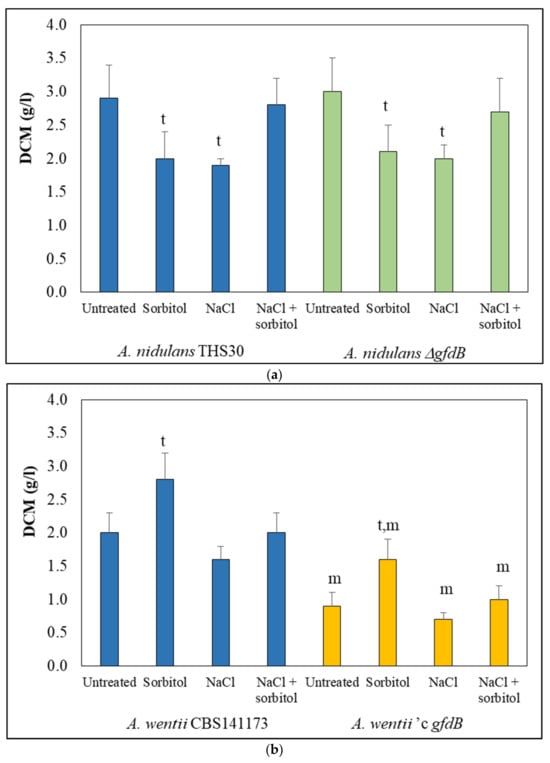
Figure 1
Open AccessReview
Hidden Treasure: Halophilic Fungi as a Repository of Bioactive Lead Compounds
by
Shivankar Agrawal, Pruthviraj Chavan and Laurent Dufossé
J. Fungi 2024, 10(4), 290; https://doi.org/10.3390/jof10040290 - 16 Apr 2024
Abstract
The pressing demand for novel compounds to address contemporary health challenges has prompted researchers to venture into uncharted territory, including extreme ecosystems, in search of new natural pharmaceuticals. Fungi capable of tolerating extreme conditions, known as extremophilic fungi, have garnered attention for their
[...] Read more.
The pressing demand for novel compounds to address contemporary health challenges has prompted researchers to venture into uncharted territory, including extreme ecosystems, in search of new natural pharmaceuticals. Fungi capable of tolerating extreme conditions, known as extremophilic fungi, have garnered attention for their ability to produce unique secondary metabolites crucial for defense and communication, some of which exhibit promising clinical significance. Among these, halophilic fungi thriving in high-salinity environments have particularly piqued interest for their production of bioactive molecules. This review highlights the recent discoveries regarding novel compounds from halotolerant fungal strains isolated from various saline habitats. From diverse fungal species including Aspergillus, Penicillium, Alternaria, Myrothecium, and Cladosporium, a plethora of intriguing molecules have been elucidated, showcasing diverse chemical structures and bioactivity. These compounds exhibit cytotoxicity against cancer cell lines such as A549, HL60, and K-562, antimicrobial activity against pathogens like Escherichia coli, Bacillus subtilis, and Candida albicans, as well as radical-scavenging properties. Notable examples include variecolorins, sclerotides, alternarosides, and chrysogesides, among others. Additionally, several compounds display unique structural motifs, such as spiro-anthronopyranoid diketopiperazines and pentacyclic triterpenoids. The results emphasize the significant promise of halotolerant fungi in providing bioactive compounds for pharmaceutical, agricultural, and biotechnological uses. However, despite their potential, halophilic fungi are still largely unexplored as sources of valuable compounds.
Full article
(This article belongs to the Special Issue Fungi and Fungal Metabolites for the Improvement of Human and Animal Life, Nutrition and Health 3.0)
►▼
Show Figures
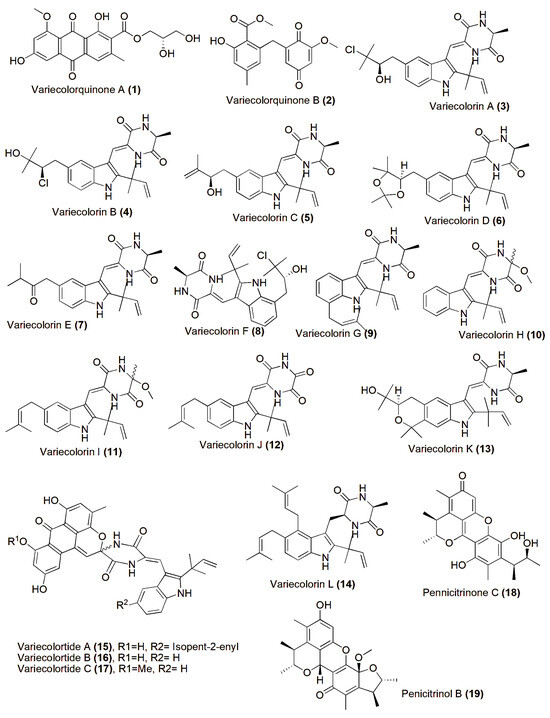
Figure 1
Open AccessArticle
Fusarium, Scedosporium and Other Rare Mold Invasive Infections: Over Twenty-Five-Year Experience of a European Tertiary-Care Center
by
Marie-Pierre Ledoux, Elise Dicop, Marcela Sabou, Valérie Letscher-Bru, Vincent Castelain, François Danion and Raoul Herbrecht
J. Fungi 2024, 10(4), 289; https://doi.org/10.3390/jof10040289 - 15 Apr 2024
Abstract
►▼
Show Figures
Invasive mold infections (IMD) are an emerging concern due to the growing prevalence of patients at risk, encompassing but not limited to allogeneic hematopoietic stem cell transplant recipients, hematological malignancies patients, solid organ transplant recipients and intensive care unit patients. In contrast with
[...] Read more.
Invasive mold infections (IMD) are an emerging concern due to the growing prevalence of patients at risk, encompassing but not limited to allogeneic hematopoietic stem cell transplant recipients, hematological malignancies patients, solid organ transplant recipients and intensive care unit patients. In contrast with invasive aspergillosis and mucormycosis, other hyalohyphomycoses and phaeohyphomycoses remain poorly known. We conducted a retrospective analysis of the clinical, biological, microbiological and evolutive features of 92 IMD having occurred in patients in our tertiary-care center over more than 25 years. A quarter of these infections were due to multiple molds. Molds involved were Fusarium spp. (36.2% of IMD with a single agent, 43.5% of IMD with multiple agents), followed by Scedosporium spp. (respectively 14.5% and 26.1%) and Alternaria spp. (respectively 13.0% and 8.7%). Mortality at day 84 was higher for Fusarium spp., Scedosporium spp. or multiple pathogens IMD compared with Alternaria or other pathogens (51.7% vs. 17.6%, p < 0.05). Mortality at day 84 was also influenced by host factor: higher among hematology and alloHSCT patients than in other patients (30.6% vs. 20.9% at day 42 and 50.0% vs. 27.9% at day 84, p = 0.041). Better awareness, understanding and treatments are awaited to improve patient prognosis.
Full article
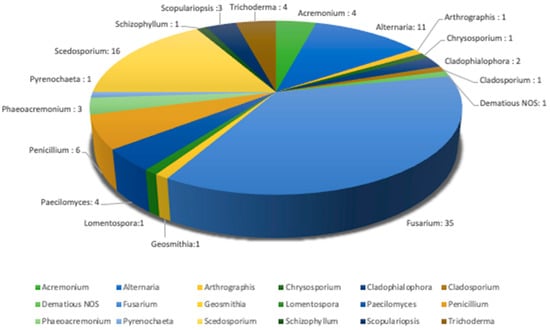
Figure 1
Open AccessArticle
FgFAD12 Regulates Vegetative Growth, Pathogenicity and Linoleic Acid Biosynthesis in Fusarium graminearum
by
Yimei Zhang, Zhen Gao, Yinyu Lei, Liuye Song, Weijie He, Jingrong Liu, Mengge Song, Yafeng Dai, Guang Yang and Andong Gong
J. Fungi 2024, 10(4), 288; https://doi.org/10.3390/jof10040288 - 14 Apr 2024
Abstract
Polyunsaturated fatty acids (PUFAs), as important components of lipids, play indispensable roles in the development of all organisms. ∆12 fatty acid desaturase (FAD12) is a speed-determining step in the biosynthesis of PUFAs. Here, we report the characterization of FAD12 in Fusarium
[...] Read more.
Polyunsaturated fatty acids (PUFAs), as important components of lipids, play indispensable roles in the development of all organisms. ∆12 fatty acid desaturase (FAD12) is a speed-determining step in the biosynthesis of PUFAs. Here, we report the characterization of FAD12 in Fusarium graminearum, which is the prevalent agent of Fusarium head blight, a destructive plant disease worldwide. The results demonstrated that deletion of the FgFAD12 gene resulted in defects in vegetative growth, conidial germination and plant pathogenesis but not sexual reproduction. A fatty acid analysis further proved that the deletion of FgFAD12 restrained the reaction of oleic acid to linoleic acid, and a large amount of oleic acid was detected in the cells. Moreover, the ∆Fgfad12 mutant showed increased resistance to osmotic stress and reduced tolerance to oxidative stress. The expression of FgFAD12 did show a temperature-dependent manner, which was not affected at a low temperature of 10 °C when compared to 25 °C. RNA-seq analysis further demonstrated that most genes enriched in fatty acid metabolism, the biosynthesis of unsaturated fatty acids, fatty acid biosynthesis, fatty acid degradation, steroid biosynthesis and fatty acid elongation pathways were significantly up-regulated in the ∆Fgfad12 mutants. Overall, our results indicate that FgFAD12 is essential for linoleic acid biosynthesis and plays an important role in the infection process of F. graminearum.
Full article
(This article belongs to the Special Issue Growth and Virulence of Plant Pathogenic Fungi)
►▼
Show Figures
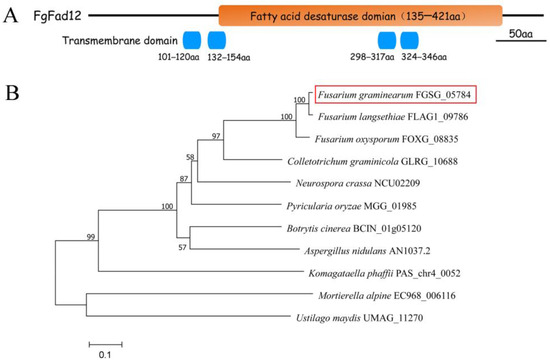
Figure 1
Open AccessReview
Sporothrix brasiliensis Causing Atypical Sporotrichosis in Brazil: A Systematic Review
by
Vanice Rodrigues Poester, Melissa Orzechowski Xavier, Lívia Silveira Munhoz, Rossana Patricia Basso, Rosely Maria Zancopé-Oliveira, Dayvison Francis Saraiva Freitas and Alessandro Comarú Pasqualotto
J. Fungi 2024, 10(4), 287; https://doi.org/10.3390/jof10040287 - 13 Apr 2024
Abstract
Zoonotic sporotrichosis, a subcutaneous mycosis caused by Sporothrix brasiliensis, has become hyperendemic and a serious public health issue in Brazil and an emerging disease throughout the world. Typical sporotrichosis is defined as fixed or lymphocutaneous lesion development, however, reports of atypical presentations
[...] Read more.
Zoonotic sporotrichosis, a subcutaneous mycosis caused by Sporothrix brasiliensis, has become hyperendemic and a serious public health issue in Brazil and an emerging disease throughout the world. Typical sporotrichosis is defined as fixed or lymphocutaneous lesion development, however, reports of atypical presentations have been described in hyperendemic areas, which may result in a worse prognosis. Thus, considering an increase in atypical cases and in more severe extracutaneous cases and hospitalizations reported in Brazil, we aimed to perform a systematic review to search for hypersensitivity reactions (HRs) and extracutaneous presentations associated with zoonotic sporotrichosis. A systematic review was performed, following the PRISMA guidelines to search for atypical/extracutaneous cases (mucosal, osteoarthritis, HRs, pulmonary, meningeal) of zoonotic sporotrichosis. A total of 791 published cases over 26 years (1998–2023) in eleven Brazilian states were reviewed. Most cases corresponded to a HR (47%; n = 370), followed by mucosal (32%; n = 256), multifocal (8%; n = 60), osteoarthritis (7%; n = 59), meningeal (4%; n = 32), and pulmonary (2%; n = 14) infections. When available (n = 607), the outcome was death in 7% (n = 43) of cases. Here, we show a frequent and worrisome scenario of zoonotic sporotrichosis in Brazil, with a high and dispersed incidence of atypical/extracutaneous cases throughout the Brazilian territory. Therefore, educational measures are necessary to make health professionals and the overall population aware of this fungal pathogen in Brazil as well as in other countries in the Americas.
Full article
(This article belongs to the Special Issue Endemic Mycoses: Recent Advances in Epidemiology, Diagnosis and Treatment)
►▼
Show Figures
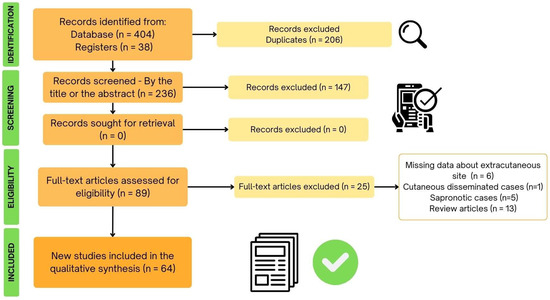
Figure 1
Open AccessArticle
Diversity of Arbuscular Mycorrhizal Fungi of the Rhizosphere of Lycium barbarum L. from Four Main Producing Areas in Northwest China and Their Effect on Plant Growth
by
Yuyao Cheng, Kaili Chen, Dalun He, Yaling He, Yonghui Lei and Yanfei Sun
J. Fungi 2024, 10(4), 286; https://doi.org/10.3390/jof10040286 - 12 Apr 2024
Abstract
►▼
Show Figures
Arbuscular mycorrhizal fungi (AMF) can help plants absorb more mineral nutrients after they colonize plant roots, and the mycelia harmonize the soil structure and physical and chemical properties by secreting compounds. AMF species co-evolve with their habitat’s geographic conditions and hosts; this gradually
[...] Read more.
Arbuscular mycorrhizal fungi (AMF) can help plants absorb more mineral nutrients after they colonize plant roots, and the mycelia harmonize the soil structure and physical and chemical properties by secreting compounds. AMF species co-evolve with their habitat’s geographic conditions and hosts; this gradually causes differences in the AMF species. By using Melzer’s reagent to analyze the morphology and using Illumina Miseq sequencing technology to perform the molecular identification of AMF communities among the four typical L. barbarum planting areas (Zhongning, Guyuan, Jinghe, and Dulan) investigated, the variety of L. barbarum roots and rhizosphere AMF communities was greater in the Zhongning area, and every region additionally had endemic species. The successfully amplified AMF was re-applied to the L. barbarum seedlings. We found that the total dry weight and accumulation of potassium increased significantly (p < 0.05), and the root volume and number of root branches were significantly higher in the plants that were inoculated with Paraglomus VTX00375 in the pot experiment, indicating that AMF improves root development and promotes plant growth. We have investigated AMF germplasm species in four regions, and we are committed to the development of native AMF resources. The multiplication and application of AMF will be conducive to realizing the potential role of biology in the maintenance of agroecology.
Full article

Figure 1
Open AccessArticle
Enhancing Candida auris Surveillance in High-Risk Settings by Implementing a High-Throughput Molecular Assay on the Hologic Fusion Open Access Platform
by
Filipe M. Cerqueira, Jennifer Bertsch, Mary Ann DeMaet, Teresa York, April McDougal, Janak A. Patel and Ping Ren
J. Fungi 2024, 10(4), 285; https://doi.org/10.3390/jof10040285 - 12 Apr 2024
Abstract
Candida auris, a resilient pathogenic yeast with frequent multidrug resistance, presents a persistent challenge in healthcare settings. The timely identification of C. auris is crucial for infection control and prevention, especially in facilities facing unique hurdles, such as our institution, which serves
[...] Read more.
Candida auris, a resilient pathogenic yeast with frequent multidrug resistance, presents a persistent challenge in healthcare settings. The timely identification of C. auris is crucial for infection control and prevention, especially in facilities facing unique hurdles, such as our institution, which serves four major hospitals and approximately 80% of the Texas inmate population. Understaffing, communal living, and financial constraints exacerbate infection control issues. To address common staff shortages, streamline testing services, and enhance testing efficiency, there was a pressing need for rapid and high-throughput detection of C. auris. This study presents the validation and utility of an assay implemented on the Hologic Fusion Open Access platform using samples collected from high-risk patients’ axilla and groin areas, as well as environmental swab samples from patient rooms. Our assay complemented efforts to control C. auris outbreaks within our healthcare system, providing valuable insights into its presence within surveillance samples. This assay demonstrated the value of high-throughput molecular detection platforms in challenging healthcare environments by aiding infection preventionists in containing the spread of C. auris and preventing nosocomial infections. Our research contributes essential data on the suitability and performance of the Hologic Fusion Open Access platform for C. auris detection. These findings hold significant implications for enhancing surveillance and control measures in high-risk settings, making a significant impact on the field of infection control and prevention.
Full article
(This article belongs to the Special Issue Infection Prevention and Control of Fungal Infections)
►▼
Show Figures
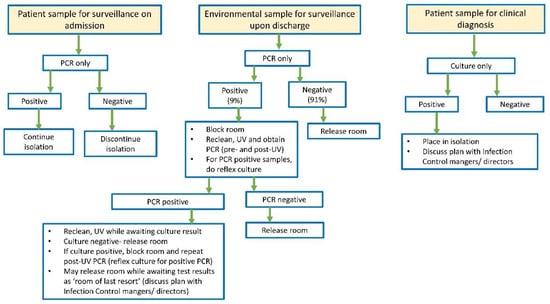
Figure 1
Open AccessArticle
Biocontrol Potential of Trichoderma Ghanense and Trichoderma Citrinoviride toward Pythium aphanidermatum
by
Badriya Khalfan Al-Shuaibi, Elham Ahmed Kazerooni, Dua’a Al-Maqbali, Moza Al-Kharousi, Mohamed N. Al-Yahya’ei, Shah Hussain, Rethinasamy Velazhahan and Abdullah Mohammed Al-Sadi
J. Fungi 2024, 10(4), 284; https://doi.org/10.3390/jof10040284 - 12 Apr 2024
Abstract
Pythium-induced damping-off of cucumber is a major constraint to cucumber production in different parts of the world. Although chemical fungicides are used for managing this disease, they have many drawbacks to the environment. The ability of the antagonistic fungi isolated from the
[...] Read more.
Pythium-induced damping-off of cucumber is a major constraint to cucumber production in different parts of the world. Although chemical fungicides are used for managing this disease, they have many drawbacks to the environment. The ability of the antagonistic fungi isolated from the rhizosphere and endosphere of Dactyloctenium robecchii and Moraea sisyrinchium in the control of soilborne pathogen Pythium aphanidermatum was inspected. Native Trichoderma isolates, Trichoderma ghanense and Trichoderma citrinoviride, were isolated from plant stem and soil samples collected from Al-Seeb, Oman. Using a dual culture technique, the antagonistic activity of the fungal isolates against P. aphanidermatum was examined in vitro. Among Trichoderma isolates, T. ghanense was more efficient in restraining the mycelial growth of P. aphanidermatum, causing an inhibition percentage of 44.6%. Further, T. citrinoviride induced significantly lower cessation of P. aphanidermatum mycelial growth (31.3%). Microscopic and electrolyte leakage inspection of the pathogen mycelia depicted extreme morphological malformations in their mycelium, which can be attributed to the antifungal metabolites of antagonists. Greenhouse studies demonstrated the effectivity of T. ghanense in controlling Pythium damping-off of cucumber plants, where the number of surviving plants was over 90% when the biocontrol agents were used compared to 0 in the control plants. Furthermore, treatment of the plants with the antagonists promoted growth characteristics of plants compared to uninoculated plants. This included improvements in shoot and root lengths, leaf length and width, and dry weight. These findings suggest that T. ghanense and T. citrinoviride can be developed as alternatives to synthetic chemical fungicides to manage soilborne pathogens of cucumber. This research is also the first to clarify the biocontrol ability of T. citrinoviride and T. ghanense against cucumber damping-off caused by P. aphanidermatum.
Full article
(This article belongs to the Special Issue Fungal Endophytes in Agriculture)
►▼
Show Figures
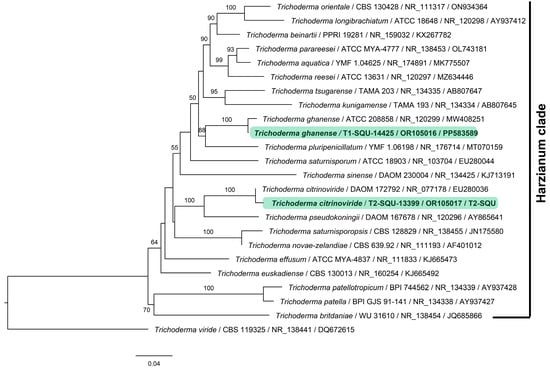
Figure 1
Open AccessArticle
Arbuscular Mycorrhizal Fungi-Mediated Modulation of Physiological, Biochemical, and Secondary Metabolite Responses in Hemp (Cannabis sativa L.) under Salt and Drought Stress
by
Haipeng Yuan, Hao Si, Yunshu Ye, Qiuyan Ji, Haoyu Wang and Yuhong Zhang
J. Fungi 2024, 10(4), 283; https://doi.org/10.3390/jof10040283 - 12 Apr 2024
Abstract
►▼
Show Figures
The increasing impact of global climate change has resulted in adversity stresses, like salt and drought, gradually becoming the main factors that limit crop growth. Hemp, which contains numerous medicinal active components and multiple bioactive functions, is widely used in the agricultural, industrial,
[...] Read more.
The increasing impact of global climate change has resulted in adversity stresses, like salt and drought, gradually becoming the main factors that limit crop growth. Hemp, which contains numerous medicinal active components and multiple bioactive functions, is widely used in the agricultural, industrial, and medical fields, hence promoting the rapid development of related industries. Arbuscular mycorrhizal fungi (AMF) can establish a symbiotic relationship with 80% of vascular plants. This symbiosis promotes host plant growth, regulates plant physiology and biochemistry, facilitates secondary metabolite synthesis, and enhances resistance to abiotic stresses. However, the effects of salt stress, drought stress, and AMF interaction in hemp are not well understood. In this study, to investigate this, we performed a study where we cultured hemp that was either inoculated or uninoculated with Funneliformis mosseae and determined changes in effective colonization rate, growth, soluble substances, photosynthesis, fluorescence, ions, and secondary metabolites by cultivating hemp under different concentrations of NaCl (0 mM, 100 mM, and 200 mM) and different soil moisture content (45%, 25%, and 15%). The results showed that salt, drought stress, or salt–drought interaction stress all inhibited colonization rate after stress, plant growth, mainly due to ion toxicity and oxidative damage. Inoculation with F. mosseae effectively alleviated plant growth inhibition under 100 mM NaCl salt stress, drought stress, and salt–drought interaction stress conditions. It also improved osmoregulation, photosynthetic properties, fluorescence properties, and ion homeostasis, and promoted the accumulation of secondary metabolites. However, under 200 mM NaCl salt stress conditions, inoculation with F. mosseae negatively affected plant physiology, biochemistry, and secondary metabolite synthesis, although it did alleviate growth inhibition. The results demonstrate that there are different effects of salt–drought interaction stress versus single stress (salt or drought stress) on plant growth physiology. In addition, we provide new insights about the positive effects of AMF on host plants under such stress conditions and the effects of AMF on plants under high salt stress.
Full article

Graphical abstract
Open AccessArticle
Guideline Adherence and Outcomes of Patients with Candidemia in Brazil
by
Jordana Machado Araujo, João Nóbrega de Almeida Junior, Marcello Mihailenko Chaves Magri, Silvia Figueiredo Costa and Thaís Guimarães
J. Fungi 2024, 10(4), 282; https://doi.org/10.3390/jof10040282 - 12 Apr 2024
Abstract
Candidemia is a significant cause of mortality among hospitalized patients, both worldwide and in Brazil. Prompt and appropriate treatment are essential to mitigate mortality, and clinical practice guidelines aim to optimize patient care based on the best scientific evidence. This study aims to
[...] Read more.
Candidemia is a significant cause of mortality among hospitalized patients, both worldwide and in Brazil. Prompt and appropriate treatment are essential to mitigate mortality, and clinical practice guidelines aim to optimize patient care based on the best scientific evidence. This study aims to examine the management of candidemia, assessing adherence to the guidelines of the Brazilian Society of Infectious Diseases in a single center located at São Paulo, Brazil. All adult patients hospitalized from 2016 to 2018 who presented one positive blood culture for Candida spp. were included. Electronic medical records were retrospectively reviewed to collect information relevant to the treatment for candidemia, in order to assess the adherence to the Brazilian guideline for the management of candidemia in relation to nine defined outcomes, and we correlated those findings with 30-day mortality by using uni- and multivariate analyses. A total of 115 patients were included; 68 patients (59.1%) were male, with a mean age of 55 years. C. albicans, C. tropicalis and C. glabrata were the most prevalent species. In total, 80 patients (69.5%) received antifungal treatment. The adherence to Brazilian guideline recommendations was determined as described in the following: initial treatment with echinocandin in 48 (60%); step-down to fluconazole in 21 (26.2%); collection of first control blood culture in 43 (58.9%); collection of second control blood culture, if the first one had been positive, in 14 (73.6%); treatment for 14 days after the first negative blood culture in 53 (65.4%); central venous catheter (CVC) removal in 66 (82.5%); CVC removal if the first control blood culture had been positive in 17 (89.4%); performance of a transthoracic echocardiogram in 51 (63.7%) and performance of a fundoscopy in 59 (73.7%). Univariate analysis showed that CVC removal and initial echinocandin therapy were more prevalent in the surviving group, but with no statistically significant difference. On the other hand, step-down to fluconazole demonstrated higher survival rate in the multivariate analysis OR 0.15 (95% CI 0.03–0.8); p = 0.02. The analysis of these nine recommendations demonstrates that it is necessary to improve adherence to specific recommendations and also disseminate strategies of the initial use of echinocandin as the drug of choice and addressing length of treatment and follow-up and complementary exams. Our study provides reassurance that the step-down to fluconazole is safe and may be recommended, if the preexisting conditions are present.
Full article
(This article belongs to the Special Issue Medical Mycology in Developing Countries: The Neglected and Forgotten Mycoses)
Open AccessArticle
Sunken Riches: Ascomycete Diversity in the Western Mediterranean Coast through Direct Plating and Flocculation, and Description of Four New Taxa
by
Daniel Guerra-Mateo, José F. Cano-Lira, Ana Fernández-Bravo and Josepa Gené
J. Fungi 2024, 10(4), 281; https://doi.org/10.3390/jof10040281 - 11 Apr 2024
Abstract
The Mediterranean Sea stands out as a hotspot of biodiversity, whose fungal composition remains underexplored. Marine sediments represent the most diverse substrate; however, the challenge of recovering fungi in culture hinders the precise identification of this diversity. Concentration techniques like skimmed milk flocculation
[...] Read more.
The Mediterranean Sea stands out as a hotspot of biodiversity, whose fungal composition remains underexplored. Marine sediments represent the most diverse substrate; however, the challenge of recovering fungi in culture hinders the precise identification of this diversity. Concentration techniques like skimmed milk flocculation (SMF) could represent a suitable solution. Here, we compare the effectiveness in recovering filamentous ascomycetes of direct plating and SMF in combination with three culture media and two incubation temperatures, and we describe the fungal diversity detected in marine sediments. Sediments were collected at different depths on two beaches (Miracle and Arrabassada) on the Spanish western Mediterranean coast between 2021 and 2022. We recovered 362 strains, and after a morphological selection, 188 were identified primarily with the LSU and ITS barcodes, representing 54 genera and 94 species. Aspergillus, Penicillium, and Scedosporium were the most common genera, with different percentages of abundance between both beaches. Arrabassada Beach was more heterogeneous, with 42 genera representing 60 species (Miracle Beach, 28 genera and 54 species). Although most species were recovered with direct plating (70 species), 20 species were exclusively obtained using SMF as a sample pre-treatment, improving our ability to detect fungi in culture. In addition, we propose three new species in the genera Exophiala, Nigrocephalum, and Queenslandipenidiella, and a fourth representing the novel genus Schizochlamydosporiella. We concluded that SMF is a useful technique that, in combination with direct plating, including different culture media and incubation temperatures, improves the chance of recovering marine fungal communities in culture-dependent studies.
Full article
(This article belongs to the Special Issue Diversity and Ecology of Fungi from Underexplored and Extreme Environments)
►▼
Show Figures
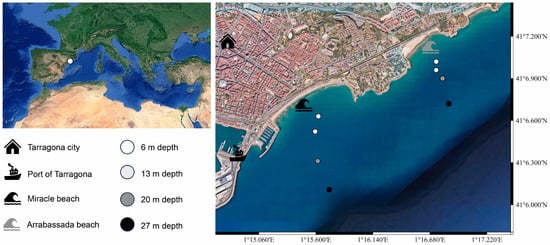
Figure 1
Open AccessArticle
Impacts of Managed Vegetation Restoration on Arbuscular Mycorrhizal Fungi and Diazotrophs in Karst Ecosystems
by
Mingming Sun, Dan Xiao, Wei Zhang and Kelin Wang
J. Fungi 2024, 10(4), 280; https://doi.org/10.3390/jof10040280 - 10 Apr 2024
Abstract
The crucial functional arbuscular mycorrhizal fungi (AMF) and diazotrophs play pivotal roles in nutrient cycling during vegetation restoration. However, the impact of managed vegetation restoration strategies on AMF and diazotroph communities remains unclear. In this study, we investigated the community structure and diversity
[...] Read more.
The crucial functional arbuscular mycorrhizal fungi (AMF) and diazotrophs play pivotal roles in nutrient cycling during vegetation restoration. However, the impact of managed vegetation restoration strategies on AMF and diazotroph communities remains unclear. In this study, we investigated the community structure and diversity of AMF and diazotrophs in a karst region undergoing managed vegetation restoration from cropland. Soil samples were collected from soils under three vegetation restoration strategies, plantation forest (PF), forage grass (FG), and a mixture of plantation forest and forage grass (FF), along with a control for cropland rotation (CR). The diversity of both AMF and diazotrophs was impacted by managed vegetation restoration. Specifically, the AMF Shannon index was higher in CR and PF compared to FF. Conversely, diazotroph richness was lower in CR, PF, and FG than in FF. Furthermore, both AMF and diazotroph community compositions differed between CR and FF. The relative abundance of AMF taxa, such as Glomus, was lower in FF compared to the other three land-use types, while Racocetra showed the opposite trend. Among diazotroph taxa, the relative abundance of Anabaena, Nostoc, and Rhizobium was higher in FF than in CR. Soil properties such as total potassium, available potassium, pH, and total nitrogen were identified as the main factors influencing AMF and diazotroph diversity. These findings suggest that AMF and diazotroph communities were more sensitive to FF rather than PF and FG after managed vegetation restoration from cropland, despite similar levels of soil nutrients among PF, FG, and FF. Consequently, the integration of diverse economic tree species and forage grasses in mixed plantations notably altered the diversity and species composition of AMF and diazotrophs, primarily through the promotion of biocrust formation and root establishment.
Full article
(This article belongs to the Special Issue Diversity and Biotechnology of Soil Fungi and Rhizosphere Fungi)
►▼
Show Figures
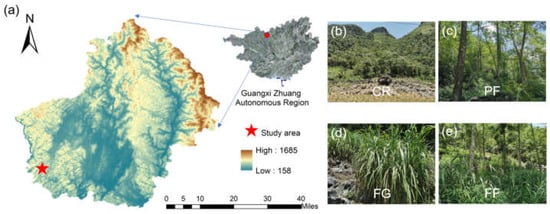
Figure 1
Open AccessArticle
Host–Pathogen Interactions and Correlated Factors That Are Affected in Replicative-Aged Cryptococcus neoformans
by
Vanessa K. A. Silva, Sungyun Min, Kyungyoon Yoo and Bettina C. Fries
J. Fungi 2024, 10(4), 279; https://doi.org/10.3390/jof10040279 - 10 Apr 2024
Abstract
Cryptococcus neoformans is a facultative intracellular fungal pathogen. Ten-generation-old (10GEN) C. neoformans cells are more resistant to phagocytosis and killing by macrophages than younger daughter cells. However, mechanisms that mediate this resistance and intracellular parasitism are poorly understood. Here, we identified important factors
[...] Read more.
Cryptococcus neoformans is a facultative intracellular fungal pathogen. Ten-generation-old (10GEN) C. neoformans cells are more resistant to phagocytosis and killing by macrophages than younger daughter cells. However, mechanisms that mediate this resistance and intracellular parasitism are poorly understood. Here, we identified important factors for the intracellular survival of 10GEN C. neoformans, such as urease activity, capsule synthesis, and DNA content using flow cytometry and fluorescent microscopy techniques. The real-time visualization of time-lapse imaging was applied to determine the phagosomal acidity, membrane permeability, and vomocytosis (non-lytic exocytosis) rate in J774 macrophages that phagocytosed C. neoformans of different generational ages. Our results showed that old C. neoformans exhibited higher urease activity and enhanced Golgi activity. In addition, old C. neoformans were more likely to be arrested in the G2 phase, resulting in the occasional formation of aberrant trimera-like cells. To finish, the advanced generational age of the yeast cells slightly reduced vomocytosis events within host cells, which might be associated with increased phagolysosome pH and membrane permeability. Altogether, our results suggest that old C. neoformans prevail within acidic phagolysosomes and can manipulate the phagosome pH. These strategies may be used by old C. neoformans to resist phagosomal killing and drive cryptococcosis pathogenesis. The comprehension of these essential host–pathogen interactions could further shed light on mechanisms that bring new insights for novel antifungal therapeutic design.
Full article
(This article belongs to the Special Issue New Perspectives on Cryptococcus and Cryptococcosis)
►▼
Show Figures
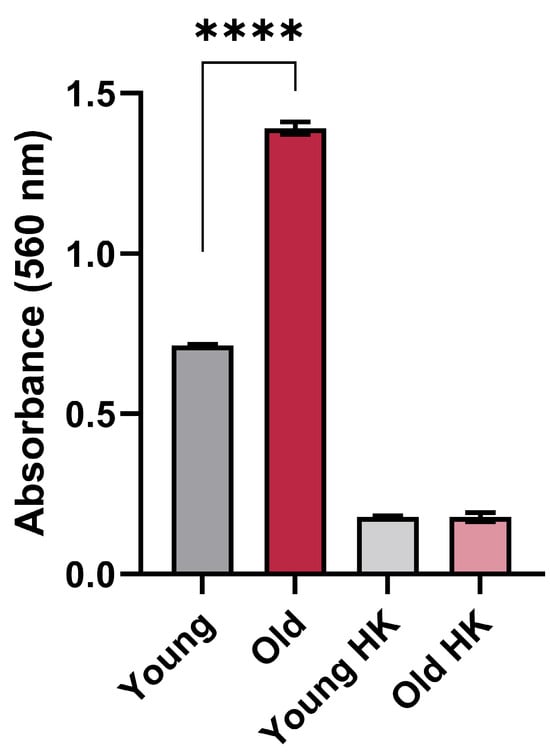
Figure 1
Open AccessReview
Amphotericin B in the Era of New Antifungals: Where Will It Stand?
by
Karolina Akinosoglou, Emmanouil Angelos Rigopoulos, Despoina Papageorgiou, Georgios Schinas, Eleni Polyzou, Effrosyni Dimopoulou, Charalambos Gogos and George Dimopoulos
J. Fungi 2024, 10(4), 278; https://doi.org/10.3390/jof10040278 - 10 Apr 2024
Abstract
Amphotericin B (AmB) has long stood as a cornerstone in the treatment of invasive fungal infections (IFIs), especially among immunocompromised patients. However, the landscape of antifungal therapy is evolving. New antifungal agents, boasting novel mechanisms of action and better safety profiles, are entering
[...] Read more.
Amphotericin B (AmB) has long stood as a cornerstone in the treatment of invasive fungal infections (IFIs), especially among immunocompromised patients. However, the landscape of antifungal therapy is evolving. New antifungal agents, boasting novel mechanisms of action and better safety profiles, are entering the scene, presenting alternatives to AmB’s traditional dominance. This shift, prompted by an increase in the incidence of IFIs, the growing demographic of immunocompromised individuals, and changing patterns of fungal resistance, underscores the continuous need for effective treatments. Despite these challenges, AmB’s broad efficacy and low resistance rates maintain its essential status in antifungal therapy. Innovations in AmB formulations, such as lipid complexes and liposomal delivery systems, have significantly mitigated its notorious nephrotoxicity and infusion-related reactions, thereby enhancing its clinical utility. Moreover, AmB’s efficacy in treating severe and rare fungal infections and its pivotal role as prophylaxis in high-risk settings highlight its value and ongoing relevance. This review examines AmB’s standing amidst the ever-changing antifungal landscape, focusing on its enduring significance in current clinical practice and exploring its potential future therapeutic adaptations.
Full article
(This article belongs to the Special Issue New Strategies to Combat Human Fungal Infections)

Journal Menu
► ▼ Journal Menu-
- JoF Home
- Aims & Scope
- Editorial Board
- Reviewer Board
- Topical Advisory Panel
- Instructions for Authors
- Special Issues
- Topics
- Sections & Collections
- Article Processing Charge
- Indexing & Archiving
- Editor’s Choice Articles
- Most Cited & Viewed
- Journal Statistics
- Journal History
- Journal Awards
- Society Collaborations
- Editorial Office
Journal Browser
► ▼ Journal BrowserHighly Accessed Articles
Latest Books
E-Mail Alert
News
Topics
Topic in
Antibiotics, Antioxidants, JoF, Microbiology Research, Microorganisms
Redox in Microorganisms, 2nd Edition
Topic Editors: Michal Letek, Volker BehrendsDeadline: 31 July 2024
Topic in
Biomedicines, JoF, Pharmaceuticals, Pharmaceutics, Reports
Natural Products to Fight Fungal Infections: An Updated In Silico and In Vivo Investigation
Topic Editors: Célia Fortuna Rodrigues, Shasank Sekhar SwainDeadline: 31 December 2024

Conferences
Special Issues
Special Issue in
JoF
Advances in Trichoderma—Systemically Induced Plant Resistance and Synergistic Biocontrol with Consortia of Trichoderma and Other Organisms 2.0
Guest Editor: Jie ChenDeadline: 20 April 2024
Special Issue in
JoF
New Perspectives on Brown Rot Fungi
Guest Editors: Rita Milvia De Miccolis Angelini, Lucia LandiDeadline: 30 April 2024
Special Issue in
JoF
Mycotoxins and Toxigenic Fungi 2nd Edition
Guest Editor: Kimiko YabeDeadline: 15 May 2024
Special Issue in
JoF
Fungal Infections in Non-neutropenic Patients
Guest Editors: Eleni Magira, Olga KampouropoulouDeadline: 31 May 2024
Topical Collections
Topical Collection in
JoF
Pathogenic Fungal Infections in Cancer and Transplant Patients
Collection Editors: Marjorie Vieira Batista, Issam I Raad
Topical Collection in
JoF
Entomopathogenic and Nematophagous Fungi
Collection Editors: Jinkui Yang, Xuemei Niu
Topical Collection in
JoF
Advances in Plant Pathogenic Fungi: Diagnosis, Biological Control, and Eco-Sustainable Formulations
Collection Editors: Santa Olga Cacciola, Carlos Agustí-Brisach, Josep Armengol



